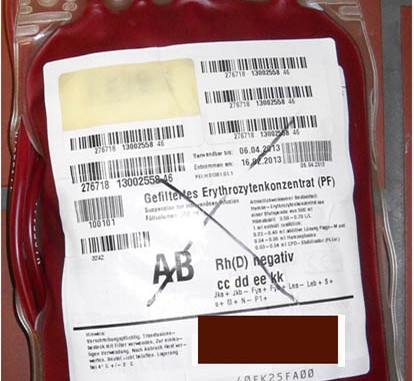
Die Farbe des Bluts.
Dass unser Blut, der „Saft des Lebens“
zuweilen eine unterschiedliche Farbe aufweisen kann, ist den meisten von uns sicher schon einmal aufgefallen:
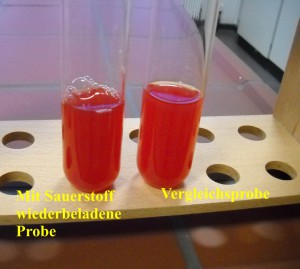
Haben wir eine Arterie verletzt, schießt hellrotes Blut stoßweise aus der Wunde im Körperkreislauf, während bei einer Verletzung einer Vene dunkelrotes Blut mehr oder weniger gleichmäßig heraus sickert. Im Wesentlichen ist es der rote Blutfarbstoff Hämoglobin, welcher bei Beladung mit Sauerstoff-Teilchen eine hellrote (kirschrote) Farbe annimmt:
Oxyhämoglobin, während er ohne Sauerstoff Dunkelrot zeigt.
Die Einschränkung „Körperkreislauf“ ist deshalb notwendig, da wir einen doppelten Kreislauf haben: das Blut wird mit zwei verschiedenen Herzkammern einerseits in den Körperkreislauf gepumpt und andererseits in den Lungenkreislauf. Der Lungenkreislauf dient zum Aufladen des Bluts mit frischen Sauerstoffteilchen. Deshalb sind die vom Herzen wegführenden Arterien dort sauerstoffarm und somit die Venen entsprechend sauerstoffreich. Eine Verletzung im Lungenkreislauf tritt aber zum Glück eher selten auf.
Blaues Blut bei Adligen
Das sprichwörtliche blaue Blut der Adligen beruht hingegen darauf, dass Adlige (vor allem die Damen) eine vornehme Blässe der Haut pflegten: Braungebrannte Haut war verpönt. Denn die hatte im Mittelalter die arme Landbevölkerung, da sie regelmäßig viele Stunden im Freien bei der Feldarbeit zubringen musste.
Der Effekt des blauen Blutes rührt nun daher, dass das venöse (dunkelrote) Blut unter der wenig muskulösen und blassen Haut, vor allem an den Handgelenken, bläulich durchschimmerte.
Adlige waren also scheinbar blaublütig.
Andere Blut-Farbe aufgrund bestimmter Vergiftungen:
- Kohlenstoff-Monooxid-Gas ist um ein Vielfachers giftiger für Menschen als Kohlenstoffdioxid. Während bei Kohlenstoffdioxid der Tod bei einer Konzentration von über 10 Prozent CO2 (100.000 ppm) nach einigen Stunden eintritt, ist dies bei Kohlenstoffmonooxid nach einer Stunde schon bei 1.500 ppm der Fall (entsprechend 0,15 % CO).
CO ist somit ca. 66 mal so giftig wie CO2.

Nach Vergiftung mit Kohlenmonoxid erfolgt die Wiederbeladung der Hämoglobin-Moleküle mit Sauerstoffteilchen nur mit starker Verzögerung. Je nach Schwere der Vergiftung, muss mitunter über mehrere Stunden eine Behandlung mit Sauerstoff erfolgen.
Bei dem Bild unten fand die Begasung mit Sauerstoff nur relativ kurze Zeit statt (ca. 20 min.).
Hinweis: Es handelt sich auch bei den stark verdünnten “Ansätzen” dennoch nicht um “Lösungen”, wie es sich im gelben Bild-Text eingeschlichen hat. Die so genanntern zellulären Bestandteile (rote und weiße Blutkörperchen, Blutplättchen) sind ja noch enthalten. Daher kann es sich im physikalisch-chemischen Sinne nicht um Lösungen handeln.
Wenn H2S (irreversibel) ans Hämoglobin bindet, entsteht das grüne Sulfhämoglobin (auch Verdoglobin genannt). Es kann den Sauerstofftransport nicht übernehmen.
Schon eine Konzentration über 100 ppm Schwefelwasserstoff kann binnen einer Stunde zum Tod führen.
H2S ist also nochmals ca. 15 x so giftig wie CO.
Gut ist, dass die Geruchsschwelle für H2S extrem niedrig ist, eine Gefahr wiederum, dass wir uns relativ schnell an den Geruch gewöhnen und ihn dann nicht mehr wahrnehmen, auch wenn er in gefährlicher Konzentration vorliegt…
-
Vergiftung mit Nitrit
Nitrit ist unter anderem in Nitrit-Pökelsalz enthalten. Aber auch Nitrate können im Magen-Darm-Trakt zu Nitriten reduziert werden, welche die wirksamen zweifach positiv geladenen Eisen-Ionen in dreifach positiv geladene verwandeln.
Insbesondere Säuglinge, die noch nicht über genügend Enzyme zur Reduktion der dreifach positiv geladenen Eisenionen aufweisen, sind gefährdet. Hohe Nitratwerte in Gemüse oder im Trinkwasser sind daher besonders für Säuglinge bedenklich.
Wie schön ersichtlich ist: Methämoglobin-Blut hat einen braunen Farbton.
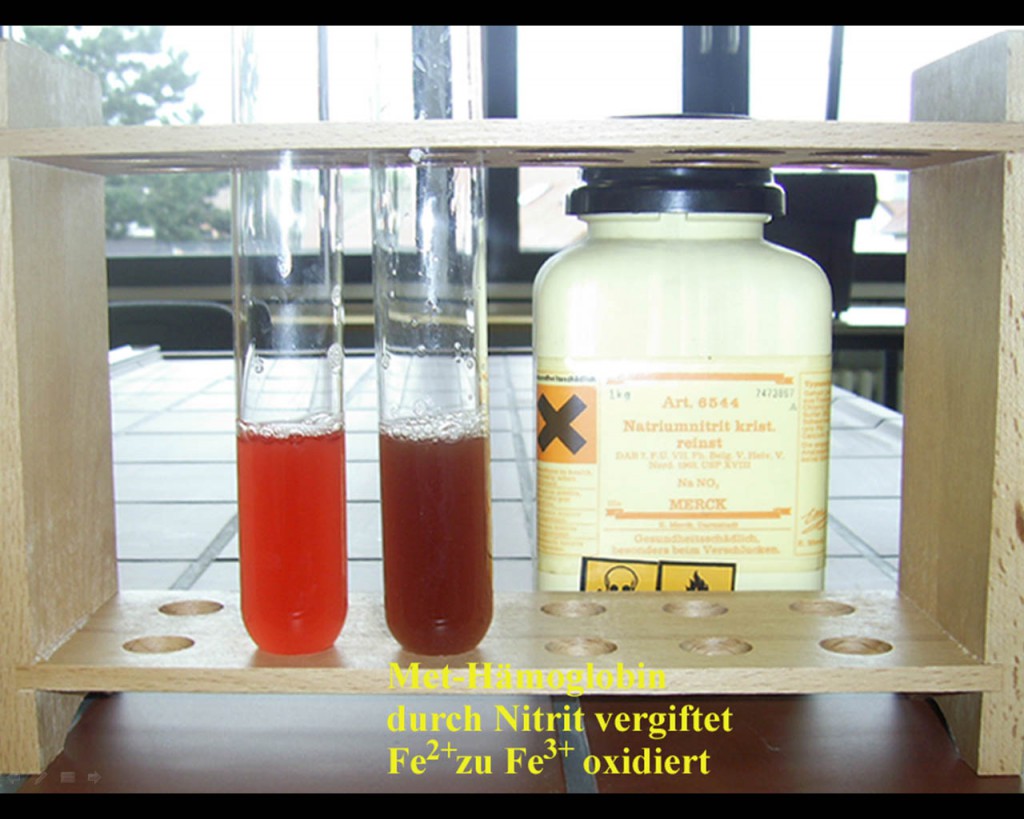
Methämoglobin durch Vergiftung mit Nitrit, Fe2+ zu Fe3+ oxidiert -
Vergiftung mit Blausäure, Cyankali, Cyaniden allgemein
Bei Vergiftung mit Cyanid (z. B. „Cyankali“) wird die Zellatmung (Endoxidation in den Zellen) blockiert. Dadurch können die Zellen keine Sauerstoffteilchen aus dem Blut verbrauchen. Das venöse Blut im Körperkreislauf ist deshalb genau so hellrot wie das arterielle.
Blausäuredämpfe führen bei einer Konzentration zwischen 100 und 200 ppm binnen einer Stunde zum Tod. Bei oraler Aufnahme von Cyankali (Kaliumcyanid) kann eine Menge von 120 Milligramm schon tödlich sein.
Laut Internetrecherche kommt der Name Blausäure vom Farbpigment Berlinerblau, in welchem Cyanid-Ionen aber sehr fest gebunden sind. Dennoch kann man aus Berliner Blau Blausäure herstellen. Es ist keineswegs so, dass Vergiftete etwa blau anliefen. Vielmehr ist das Gegenteil richtig: Da auch das venöse Blut hellrot ist, sehen Haut und Schleimhäute für einen Laien sogar sehr gesund aus.
Interessant ist, dass eines der Gegenmittel bei einer sicheren Blausäurevergiftung ausgerechnet ein Stoff ist, welcher Met-Hämoglobin erzeugt:
Wenn ca. 2/3 des Hämoglobins in dreiwertiger Form der Eisenionen vorliegen, können dadurch in der Regel die Cyanid-Ionen im Blut sicher gebunden, “abgefangen” werden, da sie sich viel lieber mit den dreifach positiv geladenen Eisenionen zusammentun. Es wird also 2/3 des Hämoglobins im Blut “geopfert”, um in den Zellen bei der Endoxidation (bei der “Zellatmung”) die “Cyotchrom-Teilchen der Atmungskette” vor den Cyanid-Ionen zu schützen. Dass dann nur noch ein Drittel des Hämoglobins im Blut für den Sauerstofftransport zur Verfügung steht, ist für den Organismus kurzfirstig verkraftbar. Die vollständige Blockade der Atmungskette wäre es dagegen nicht.
Bei einer solchen Behandlung verschwindet dann kurioserweise die scheinbar gesunde hellrote Hautfarbe der Patienten dann doch vorübergehend… Siehe oben: Methämoglobin-Blut ist braun!
Gegenmittel bei Cyanidvergiftung
Disclaimer: Alle hier aufgeführten Fakten und Rückschlüsse erfolgten nach bestem Wissen und Gewissen und ausgiebiger Recherche bei zuverlässigen Quellen. Dennoch kann ich keine Garantie für 100%ige Richtigkeit abgeben. Sollten in Ihrem Umfeld tatsächlich solche Vergiftungssymptome auftreten, muss unbedingt ein Notarzt zugezogen werden.
-
Vergiften mit destilliertem Wasser
Aufgrund von osmotischen Effekten (unterschiedlich stark konzentrierte Lösungen, von einer semi-permeablen Membran getrennt) strömen verstärkt Wassermoleküle durch die Membran der roten Blutkörperchen ins Zell-Innere, wenn diese destilliertem Wasser, einer extrem hypotonen Lösung (Lösung mit sehr wenig gelösten Teilchen), ausgesetzt werden. So lange, bis die roten Blutkörperchen (Erythrozyten) platzen. Die Zelltrümmer mitsamt den Hämoglobin-Teilchen sinken auf den Reagenzglas-Boden.
That our blood, the juice of life.
can sometimes show a different colour, most of us have certainly noticed it before:
Carbon dioxide vs. oxygen Blood
oxygenated blood
If we have injured an artery, light red blood shoots intermittently out of the wound in the body’s circulatory system, while dark red blood seeps out more or less evenly when a vein is injured. Essentially, it is the red blood pigment haemoglobin which takes on a light red (cherry red) colour when loaded with oxygen particles:
Oxyhaemoglobin, while it shows dark red without oxygen.
The restriction “body circulation” is necessary because we have a double circulation: the blood is pumped with two different heart chambers on the one hand into the body circulation and on the other hand into the lung circulation. The pulmonary circulation is used to charge the blood with fresh oxygen particles. This is why for that chamber the arteries leading away from the heart are low in oxygen and the veins are accordingly rich in oxygen. Fortunately, injuries to the pulmonary circulation are rare.
Blue blood in nobles
The proverbial blue blood of the nobles, on the other hand, is based on the fact that nobles (especially the ladies) cultivated a noble pallor of the skin: tanned skin was frowned upon. In the Middle Ages, the poor rural population had this because they regularly had to spend many hours outdoors working in the fields.
The effect of blue blood now stems from the fact that the venous (dark red) blood shimmered bluish under the less muscular and pale skin, especially on the wrists.
Nobles were therefore apparently blue-blooded.
Other blood color due to certain poisonings:
Carbon monoxide gas is many times more toxic to humans than carbon dioxide. While death occurs with carbon dioxide at a concentration of over 10 percent CO2 (100,000 ppm) after a few hours, this is already the case with carbon monoxide after one hour at 1,500 ppm (corresponding to 0.15 % CO).
CO is thus about 66 times as toxic as CO2.
Blood sample saturated with carbon monoxide
Hydrogen sulphfide gas poisoning
(Smell of rotten eggs) Sulf haemoglobin d. H2S is green
Note: Even with the highly diluted “approaches”, they are not “solutions”, as it has crept into the yellow text of the picture. The so-called cellular components (red and white blood cells, blood platelets) are still contained. Therefore, they cannot be solutions in the physical-chemical sense.
When H2S (irreversible) binds to hemoglobin, the green sulfhemoglobin (also called verdoglobin) is formed. It cannot take over the transport of oxygen.
Even a concentration of more than 100 ppm hydrogen sulphide can lead to death within an hour.
H2S is therefore about 15 times as toxic as CO.
It is good that the odor threshold for H2S is extremely low, a danger in turn that we get used to the odor relatively quickly and then no longer perceive it, even if it is present in dangerous concentrations…
Nitrite poisoning
Nitrite is contained among other things in nitrite curing salt. But nitrates can also be reduced to nitrites in the gastrointestinal tract, which transform the effective double positively charged iron ions into triple positively charged ones.
Especially infants who do not yet have enough enzymes to reduce the triple positively charged iron ions are at risk. High nitrate levels in vegetables or drinking water are therefore of particular concern to infants.
As you can see: Methaemoglobin blood has a brown colour.
Note: Even the highly diluted “preparations” are not “solutions”, as the yellow text in the picture shows. The so-called cellular components (red and white blood cells, blood platelets) are still contained. Therefore, they cannot be solutions in the physical-chemical sense.
When H2S (irreversible) binds to hemoglobin, the green sulfhemoglobin (also called verdoglobin) is formed. It cannot take over the transport of oxygen.
Even a concentration of more than 100 ppm hydrogen sulphide can lead to death within an hour.
H2S is therefore about 15 times as toxic as CO.
It is good that the odor threshold for H2S is extremely low, a danger in turn that we get used to the odor relatively quickly and then no longer perceive it, even if it is present in dangerous concentrations…
Methaemoglobin oxidized by poisoning with nitrite, Fe2+ to Fe3+
Nitrite poisoning
Nitrite is contained among other things in nitrite curing salt. However, nitrates can also be reduced to nitrites in the gastrointestinal tract, which transform the effective double positively charged iron ions into triple positively charged ones. Especially infants who do not yet have enough enzymes to reduce the triple positively charged iron ions are at risk. High nitrate levels in vegetables or in drinking water are therefore particularly alarming for infants.How beautifully it is evident: Methaemoglobin blood has a brown hue.Methaemoglobin oxidizes to Fe3+ through poisoning with nitrite, Fe2+ poisoning with prussic acid, cyanide, cyanides in generalPoisoning with cyanide (e.g. “cyanide”) blocks cell respiration (final oxidation in the cells). This prevents the cells from consuming oxygen particles from the blood. Therefore, the venous blood in the body’s circulation is just as bright red as the arterial blood. At a concentration of between 100 and 200 ppm, hydrocyanic acid vapours lead to death within one hour. According to Internet research, the name prussic acid comes from the colour pigment Berlinerblau, in which cyanide ions are very firmly bound. Nevertheless, it is possible to produce prussic acid from Berliner Blau. It is by no means the case that the poisoned ones are blue. It is interesting to note that one of the antidotes to safe hydrocyanic acid poisoning is a substance that produces Met haemoglobin:If about 2/3 of the haemoglobin is present in the trivalent form of the iron ions, the cyanide ions in the blood can usually be safely bound, “intercepted” because they vigorously prefer to combine with the triple positively charged iron ions. Thus 2/3 of the hemoglobin in the blood is “sacrificed” in order to protect the “cyotchrome particles of the respiratory chain” from the cyanide ions in the cells during final oxidation (during “cell respiration”). The fact that only one third of the hemoglobin in the blood is then available for oxygen transport can be absorbed by the organism at short notice. In contrast, the complete blockade of the respiratory chain would not be possible. In such a treatment, the apparently healthy light red skin colour of the patients then curiously disappears temporarily… See above: Methaemoglobin blood is brown!
antidote to cyanide poisoning
Disclaimer: All facts and conclusions listed here have been made to the best of our knowledge and belief and have been extensively researched from reliable sources. Nevertheless I cannot give any guarantee for 100% accuracy. Should such poisoning symptoms actually occur in your environment, an emergency doctor must be consulted. Poisoning with distilled water Due to osmotic effects (solutions of differing concentration, separated by a semi-permeable membrane), water molecules increasingly flow through the membrane of the red blood cells into the cell interior when these are exposed to distilled water, an extremely hypotonic solution (solution with very few dissolved particles). Until the red blood cells (erythrocytes) burst. The cell debris together with the haemoglobin particles sink to the test tube bottom.
Translated with www.DeepL.com/Translator

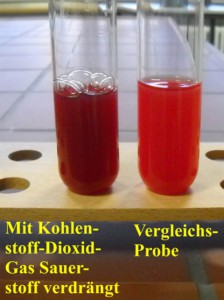
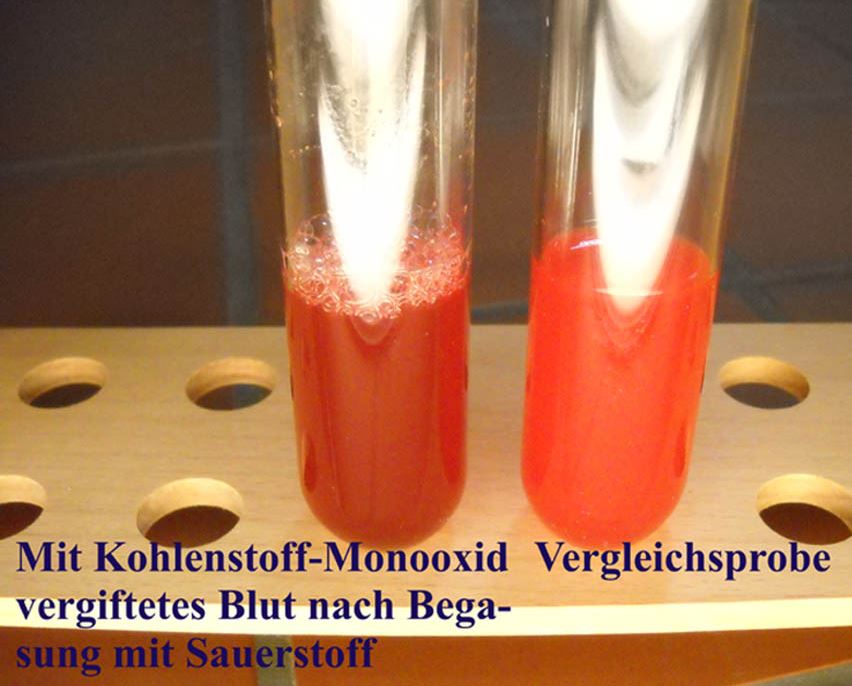
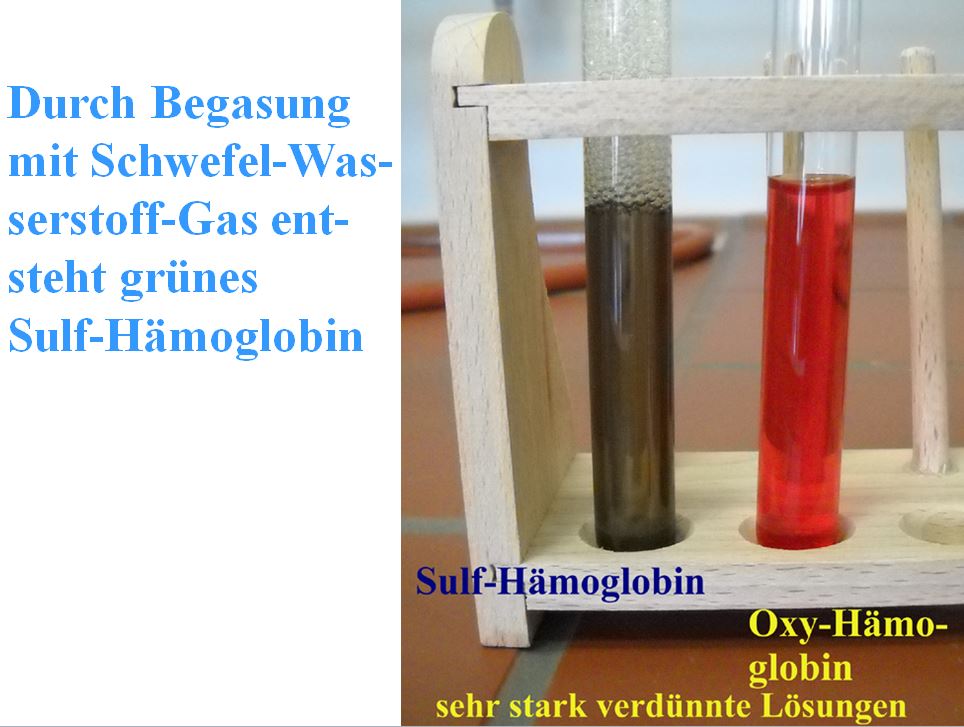
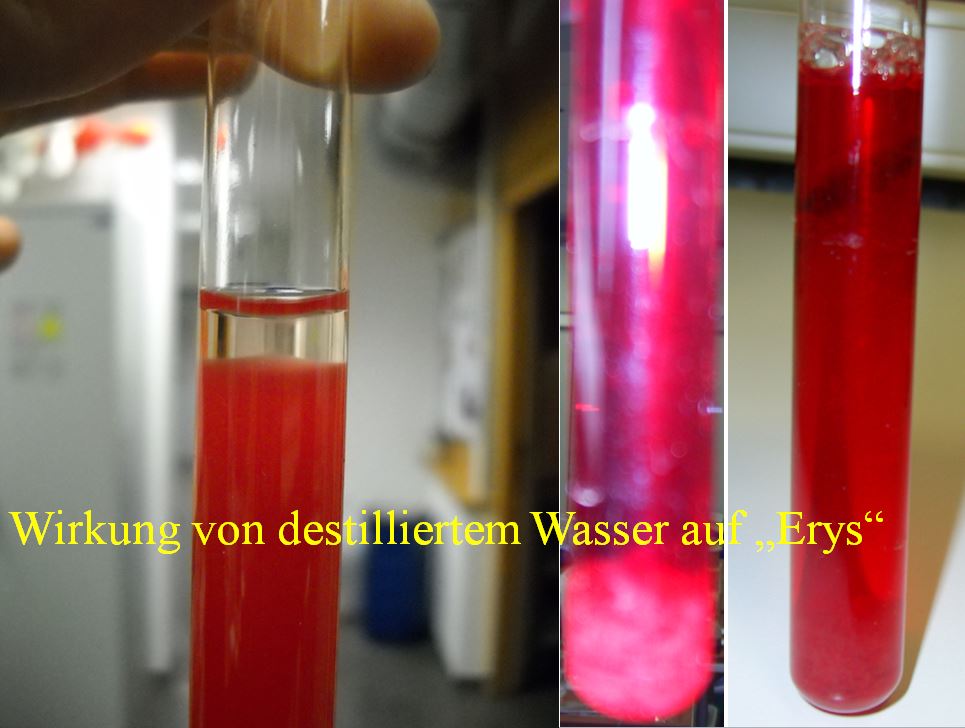
Kommentar hinterlassen